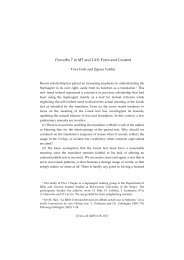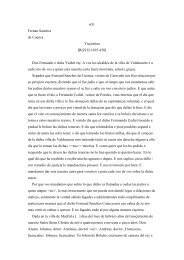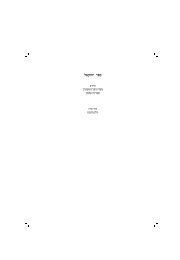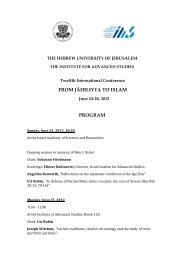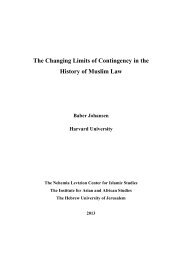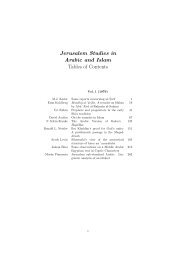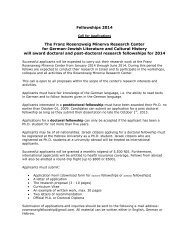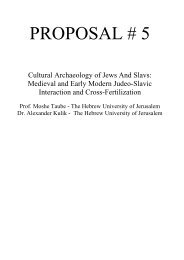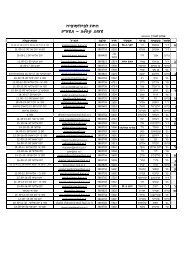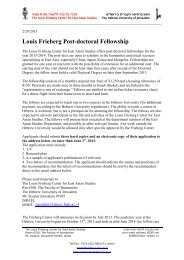THE BOOK OF EZEKIEL Moshe H. Goshen-Gottstein Shemaryahu ...
THE BOOK OF EZEKIEL Moshe H. Goshen-Gottstein Shemaryahu ...
THE BOOK OF EZEKIEL Moshe H. Goshen-Gottstein Shemaryahu ...
You also want an ePaper? Increase the reach of your titles
YUMPU automatically turns print PDFs into web optimized ePapers that Google loves.
IV. Apparatus II: The Judean Desert Scrolls and Quotations in Rabbinic Literature<br />
to the text of the book of Ezekiel and thus cannot be considered a primary source for readings<br />
deviating from MT (but cf., for example, 1:10; 10:14). Some variants from three copies<br />
of this work (4QpsEzek a = 4Q385, 4QpsEzek b = 4Q386, 4QpsEzek c = 4Q385b) have been<br />
recorded in Apparatus II and in the notes to Apparatus I, mostly when other ancient witnesses<br />
contain similar differences. 85<br />
Biblical Quotations in Rabbinic Literature<br />
60. Classical rabbinic literature makes extensive use of the Hebrew Bible. Next to the<br />
ancient versions this is the most important witness for the biblical text used by the Sages in<br />
the first centuries of the common era. Midrashic homilies on biblical passages provide a<br />
glimpse of the text current in the period preceding its transmission by the masoretes. The<br />
biblical quotations in midrash literature are not altogether identical to the MT. At times,<br />
they reflect a variant vocalization, and at times also a different consonantal text. 86 Rabbinic<br />
literature in all stages of its transmission presents many difficulties in the attempt to identify<br />
the biblical text used by the Sages: the manner of its production, compilation and editing,<br />
its oral tradition and written transmission, and in medieval manuscripts.<br />
61. Rabbinic literature is preserved in medieval manuscripts written hundreds of years<br />
later than its creation and editing. The text of these works preserved in these manuscripts is<br />
not always sufficiently clear, including that of the biblical quotations they contain. The accuracy<br />
of the copyists of manuscripts of rabbinic literature is not at all similar to the customarily<br />
painstaking care of copyists of biblical manuscripts, again including biblical quotations.<br />
Scribal errors affected also quotations of biblical texts. Even in regard to quotations<br />
which are not corrupted, it is not always possible to distinguish between similar letters such<br />
as o /f ,e/i ,x/c ,k/ a, etc. The text of quotations was also corrupted due to scribal habits, such<br />
as recording oft-repeated passages in abbreviation. In regard to orthography, scribes employed<br />
a plene orthography in quotation of biblical verses as in talmudic material. Furthermore,<br />
it is not always possible to distinguish between an actual biblical quotation and a<br />
85 Four copies of this composition were published by D. Dimant: “4QPseudo-Ezekiel a-d ,” Qumran Cave<br />
4, XXI: Parabiblical Texts, Part 4 (DJD 30; Oxford: Clarendon, 2001) 7–88, pl. i-iii. A fifth copy was<br />
published by M. Smith, “391. 4QpapPseudo-Ezekiel e ,” Qumran Cave 4, XIV: Parabiblical Texts, Part<br />
2 (DJD 19; ed. M. Broshi et al.; Oxford: Clarendon, 1995) 153–193, pl. xvii-xxv.<br />
86 The phenomenon was already noted by the early Sages: cf., for example, Tosaphot on b. Shabbat 55b,<br />
aizk mxiarn, and the comments of R. Akiva Eiger in Gilyon HaShas ad loc. See D. Rosenthal, “The<br />
Sages Methodical Approach to Textual Variants within the Hebrew Bible,” Isac Leo Seeligmann<br />
Volume: Essays on the Bible and the Ancient World (ed. A. Rofe ´ and Y. Zakovich; Jerusalem:<br />
E. Rubinstein, 1983) 2:395–417 (Hebrew); Y. Maori, “The Text of the Hebrew Bible in Rabbinic<br />
Writings in the Light of the Qumran Evidence,” The Dead Sea Scrolls: Fourty Years of Research (ed.<br />
D. Dimant and U. Rappaport; STDJ 10; Leiden: Brill, 1992) 283–289. The main lists of variants in<br />
biblical quotations in the Talmud were compiled by S. Rozenfeld, Mishpahat . Sopherim (Vilna:<br />
Romm, 1882); V. Aptowitzer, Das Schriftwort in der rabbinischen Literatur (2 vols.; Vienna<br />
1906–1915; repr. New York: Ktav, 1970). See also M. Kahana, “The Biblical Text Reflected in Ms<br />
Vatican 32 of Sifre Numbers and Deuteronomy,” Talmudic Studies 1 (ed. Y. Sussman and<br />
D. Rosenthal; Jerusalem: Magnes, 1990) 1–10; I. Knohl and S. Naeh, “Studies in the Priestly Torah:<br />
Lev. 7:19–21,” The Bible in the Light of Its Interpreters: Sarah Kamin Memorial Volume (ed.<br />
S. Japhet; Jerusalem: Magnes, 1994) 601–612 (Hebrew).<br />
xxxi



